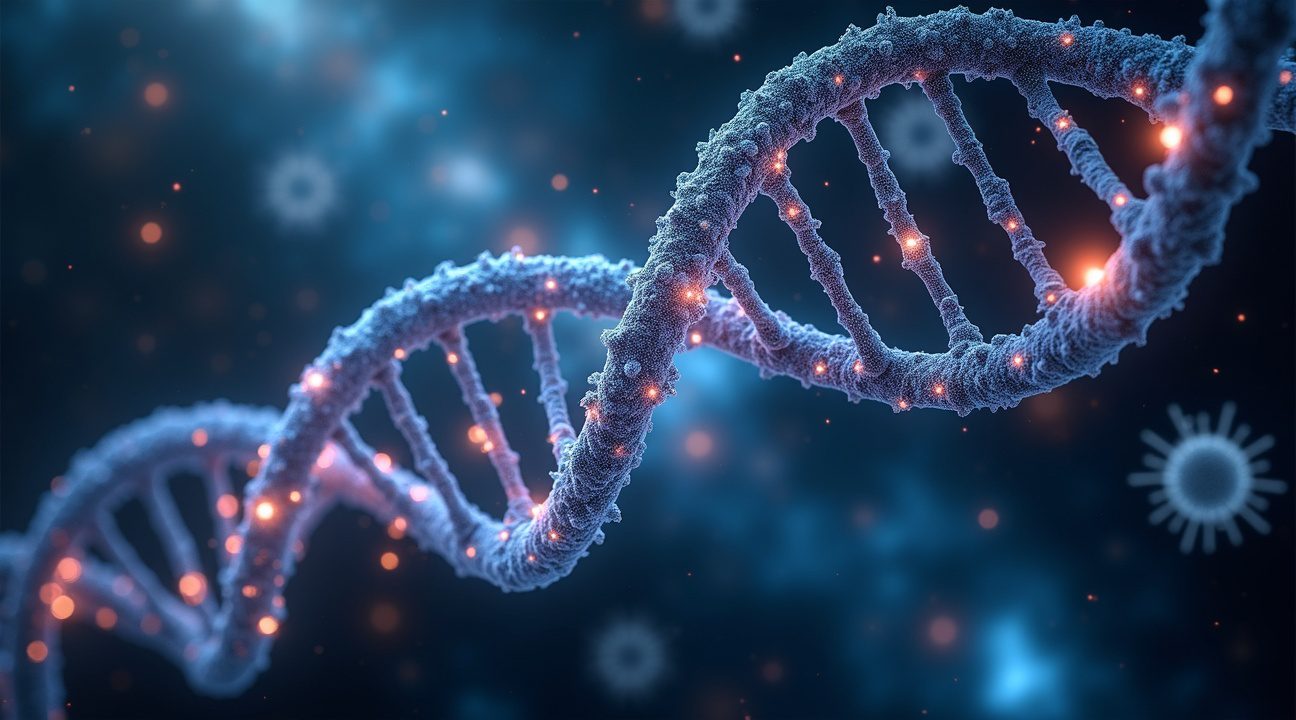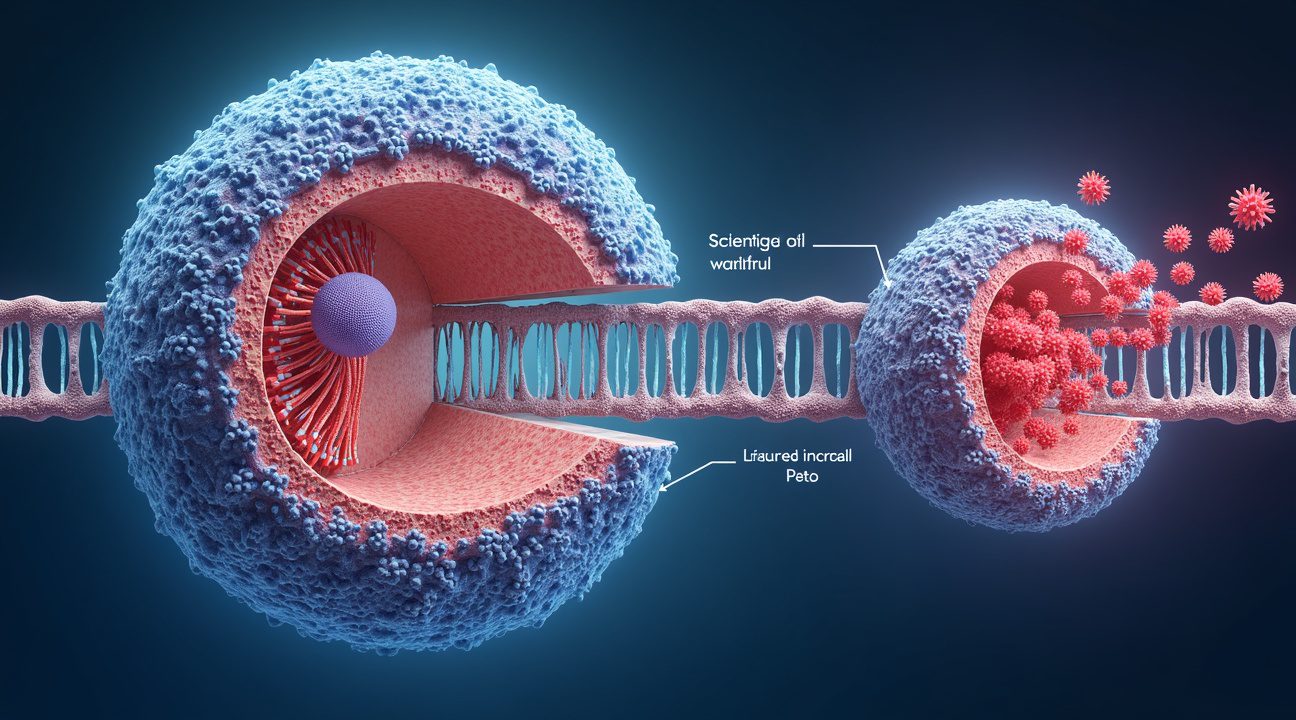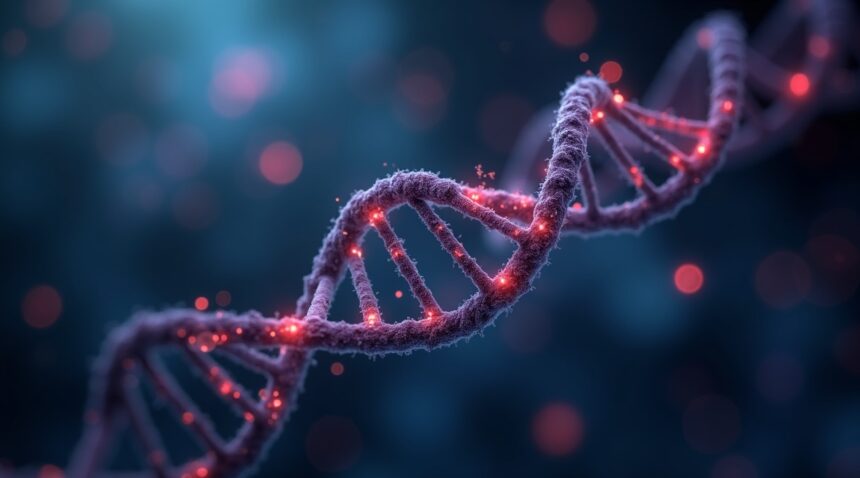Scientists have achieved a major breakthrough by successfully reactivating Risea Vee, an ancient virus embedded within human DNA for millions of years, highlighting that dormant genetic fossils can remain functional over vast stretches of evolutionary time.
Understanding the Role of Endogenous Retroviruses in Human DNA
Approximately 8% of the human genome is comprised of endogenous retroviruses (ERVs), which are viral remnants passed down from ancestral infections. These elements have remained dormant in the human genome, offering fascinating clues about human evolution and disease associations.
Ancient Infection Reawakened in Labs
Under carefully controlled laboratory conditions, scientists have reactivated HML-2, a subclass of endogenous retroviruses, revealing that these sequences retain the capacity to produce functional viral particles. The active Risea Vee virus was observed to generate viral elements capable of transmission between human cells.
Why Aren’t These Viruses Always Active?
The human body suppresses these dormant viruses using natural mechanisms such as DNA methylation and other epigenetic modifications. However, these regulatory systems can weaken in specific instances—such as cancer, cellular aging, or extreme physiological stress—potentially permitting the viruses to awaken and induce negative effects.
Key Takeaways
- Ancient viral DNA represents about 8% of the human genome and originates from infections millions of years ago that became integrated into hereditary material.
- Lab reactivation of dormant HML-2 viruses demonstrates that these genetic elements can produce functional particles under the right conditions.
- Cellular suppression mechanisms like DNA methylation typically keep these viruses inactive—but may falter in cases such as cancer or advanced aging.
- Health implications include immune system disruption and contributions to diseases like cancer, neurodegenerative disorders, and chronic inflammation-related aging.
- Medical innovations are emerging, with scientists using viral systems like DNA-launched virus replicons to advance vaccines and gene therapy technologies.
This area of research continues to evolve, offering insight into both the hidden history of our genome and the potential for innovative biotechnological applications. For more on this fascinating study, explore the full coverage from Nature.
Ancient Viral DNA Makes Up 8% of Human Genome
I find it fascinating that approximately 8% of the human genome consists of ancient viral sequences that have been quietly residing within our DNA for millions of years. These sequences, known as endogenous retroviruses or ERVs, represent genetic remnants from viral infections that occurred so long ago they’ve become permanent fixtures in human heredity.
These viral relics tell an extraordinary story of survival and adaptation. Ancient pandemics once infected the germline cells—the reproductive cells that pass genetic information to offspring—allowing viral genetic material to become permanently integrated into the human genome. Unlike typical infections that affect only the infected individual, these ancient viruses managed to embed themselves so deeply into our genetic code that they’re now inherited from parent to child across countless generations.
What makes these viral fossils particularly intriguing is their current state of dormancy. Although these sequences have largely remained silent throughout human evolution, recent laboratory studies have demonstrated that certain ERVs can potentially be reactivated under specific conditions. This discovery has opened new avenues for understanding both our evolutionary history and potential medical applications.
Understanding Endogenous Retroviruses
ERVs function differently from modern viruses that cause temporary infections. These ancient sequences have lost most of their ability to cause disease, yet they retain enough genetic information to be recognizable as viral in origin. Scientists can trace these viral signatures back through evolutionary time, revealing how our ancestors survived massive viral pandemics that would have been devastating to early human populations.
The integration process that allowed these viruses to become permanent residents occurred when retroviruses infected germline cells and inserted their genetic material directly into chromosomal DNA. Over millions of years, these sequences accumulated mutations and became increasingly domesticated, losing their pathogenic properties while contributing to the genetic diversity that makes each person unique.
Recent research has shown that some of these ancient viral sequences still retain the capacity for activation, though they typically remain suppressed by cellular mechanisms. Laboratory conditions can sometimes trigger their reactivation, providing valuable insights into both viral evolution and potential therapeutic applications. Understanding how DNA changes through decades helps scientists better comprehend these ancient viral integrations.
The presence of these viral relics in our genome demonstrates how profoundly viruses have shaped human evolution, creating a complex genetic landscape where the boundaries between host and pathogen have become permanently blurred through millions of years of coevolution.

Laboratory Tests Successfully Reactivate Dormant Viral Elements
Scientific research has achieved remarkable breakthroughs in reactivating ancient viral components that have remained dormant within human DNA for millions of years. These laboratory tests have successfully awakened HML-2 ERVs (Human Endogenous Retrovirus-2), proving that these ancient genetic passengers can spring back to life under specific conditions.
Reactivation Process and Methodology
Researchers have developed sophisticated techniques to trigger laboratory reactivation of these dormant viral elements using carefully controlled tissue cultures. Scientists utilize both human tissues and non-human primate organs to stimulate these ancient viral sequences, creating optimal conditions for their awakening. The process involves exposing cellular samples to specific environmental stressors that mimic conditions where these viruses might naturally reactivate.
During these experiments, scientists observe the remarkable transformation of dormant genetic code into active viral machinery. The reactivated elements begin producing retrovirus-like particles that demonstrate characteristics similar to their ancient predecessors. These particles retain the ability to function as active viral components, complete with the molecular machinery necessary for reproduction and transmission.
Observable Effects and Cellular Impact
The most striking discovery involves the behavior of these reactivated particles once they become active. Scientists have documented their capacity for cell-to-cell transfer, where the newly awakened viral elements can move from one cell to another within the laboratory environment. This transfer mechanism demonstrates that these ancient viruses haven’t lost their fundamental ability to spread, despite millions of years of dormancy.
Perhaps most concerning is the observed acceleration of cellular aging when these elements reactivate. Research shows that younger cells exposed to these retrovirus-like particles experience accelerated cellular senescence, effectively aging at a faster rate than normal. This discovery suggests that these ancient viral passengers might play a role in natural aging processes when they become active within living organisms.
The laboratory findings reveal several key characteristics of reactivated viral elements:
- Production of physical retrovirus-like particles visible under microscopic examination
- Maintained ability to transfer genetic material between cells
- Acceleration of aging markers in previously healthy cellular samples
- Retention of viral replication mechanisms despite extended dormancy
- Demonstration of infectious potential within controlled environments
Laboratory observations confirm that these reactivated elements produce measurable quantities of viral particles. Scientists can actually see and count these particles using advanced microscopy techniques, providing tangible evidence of successful reactivation. The particles exhibit structural characteristics consistent with active retroviruses, including the presence of viral proteins and genetic material necessary for replication.
Understanding how DNA changes over time helps researchers grasp the significance of these reactivation events. The ability to artificially trigger these dormant elements provides unprecedented insights into human evolutionary history and the ongoing relationship between humans and their viral passengers.
These controlled laboratory conditions allow scientists to study viral reactivation without the complex variables present in living organisms. Tissue cultures provide an ideal environment for observing how these ancient elements respond to different stimuli while maintaining precise control over experimental conditions. This approach enables researchers to document exactly how dormant viral DNA transitions from inactive genetic code to functional viral machinery.
The successful reactivation of HML-2 elements represents a significant advancement in understanding how ancient viruses persist within human genetics. These experiments demonstrate that millions of years of dormancy haven’t eliminated the fundamental viral capabilities embedded within human DNA. Instead, the right laboratory conditions can awaken these sleeping giants, revealing their continued potential for activity and reproduction.
Current research continues to explore the mechanisms behind this reactivation process, seeking to understand both the triggers that awaken these elements and the cellular consequences of their return to activity. Scientists are particularly interested in determining whether similar reactivation might occur naturally within living humans under certain stress conditions or environmental factors.

How Cellular Control Systems Keep Ancient Viruses Silent
I’ve examined how cellular mechanisms maintain control over ancient viral sequences that have been dormant in human DNA for millions of years. The epigenome serves as the primary guardian, employing sophisticated chemical modifications and specialized proteins to keep these endogenous viral elements permanently silenced in healthy cells.
DNA methylation stands as the most powerful tool in this cellular arsenal. This process involves adding methyl groups to specific DNA sequences, effectively placing a “lock” on viral genetic material. When methylation occurs properly, it prevents the cellular machinery from accessing and reading these ancient viral codes. The system functions like a highly efficient library where certain dangerous books remain permanently sealed.
Epigenetic Breakdown and Viral Reactivation
Cancer cells and aging cells present a different scenario entirely. These compromised cellular environments experience weakening epigenetic controls, creating opportunities for dormant viral sequences to break free from their molecular restraints. The following factors contribute to this breakdown:
- DNA hypomethylation removes the protective methyl groups from viral sequences
- Aging cells lose their ability to maintain proper epigenetic modifications
- Cancer cells often exhibit widespread disruption of normal silencing mechanisms
- Cellular stress can trigger changes in chromatin structure that expose viral DNA
- Environmental factors may interfere with the proteins responsible for maintaining viral silence
Research has shown that when these control systems fail, cells begin producing retrovirus-like particles. These particles represent reactivated versions of the ancient viral sequences that have remained hidden in human genomes. Unlike a comparative study of DNA through decades might suggest, these reactivations don’t necessarily follow predictable patterns.
The process of viral silencing relies heavily on chromatin modifications beyond simple DNA methylation. Histone proteins, which help package DNA within cells, can be chemically modified to create additional layers of repression. These modifications work together to form what scientists call “heterochromatin” — tightly packed DNA regions that remain largely inaccessible to cellular machinery.
Viral activation occurs when this carefully orchestrated system breaks down. Cells experiencing stress, damage, or malignant transformation often lose their ability to maintain proper epigenetic control. The ancient viral sequences then begin transcribing their genetic instructions, potentially leading to the production of viral proteins and particles.
Understanding these mechanisms has implications far beyond basic research. Scientists studying phenomena like deja vu or investigating whether dinosaurs can be recreated from DNA must consider how epigenetic factors influence genetic expression over time.
The hypomethylation process deserves particular attention because it represents a critical point where cellular control begins to fail. When methyl groups are removed from viral DNA sequences, these regions become accessible to transcription factors and other cellular machinery. This accessibility essentially “wakes up” the dormant viral genetic material.
Healthy cells maintain this silencing through constant surveillance and repair mechanisms. Specialized enzymes continuously monitor methylation patterns and quickly restore any modifications that become damaged or lost. However, this system becomes less efficient with age or disease, explaining why viral reactivation appears more frequently in compromised cellular environments.
The proteins involved in maintaining viral silence form complex networks that coordinate their activities across the entire genome. These protein complexes recognize specific DNA sequences and recruit additional factors to maintain repressive chromatin states. When cancer disrupts these networks, previously silenced viral elements can suddenly become active.
Scientists continue investigating how environmental factors influence these epigenetic control systems. Some research suggests that certain chemicals, radiation, or even lifestyle factors might affect the stability of viral silencing mechanisms. This ongoing research parallels discoveries about essential building blocks for life found in unexpected places throughout the universe.
The balance between viral silencing and activation represents one of the most sophisticated regulatory systems in human biology, demonstrating how cells have evolved multiple layers of protection against potentially harmful genetic elements embedded within our DNA.

Reactivated Viruses Trigger Disease and Immune Chaos
When dormant endogenous viruses like Risea Vee awaken from their long slumber within human DNA, they can unleash a cascade of health problems that researchers are only beginning to understand. These ancient genetic fossils don’t simply reactivate harmlessly — they actively interfere with normal cellular processes and trigger widespread immune dysfunction that contributes to some of humanity’s most devastating diseases.
Disease Connections Span Multiple Body Systems
Scientists have established clear connections between reactivated endogenous viruses and several major disease categories:
- Cancer: These viral elements can disrupt normal cell growth and division patterns.
- Neurodegenerative diseases: Viral reactivation affects brain cells and nervous system function.
- Cartilage and muscle conditions: Strong correlations are observed with endogenous viral activity.
- Accelerated cellular aging: Directly linked to ancient viral awakening events.
The immune system bears the brunt of this viral chaos through multiple pathways. Type I interferon production kicks into overdrive when these genetic fossils reactivate, creating an inflammatory environment that can persist for extended periods. Pro-inflammatory cytokines including TNF, IL-6, and IL-1β flood affected tissues, amplifying immune responses beyond normal protective levels. This sustained inflammatory state doesn’t just fight the perceived viral threat — it actively damages healthy cells and tissues throughout the body.
Animal models reveal the devastating cellular consequences of endogenous viral reactivation. Increased cell death through apoptosis becomes particularly pronounced in neurons, explaining the connection to neurodegenerative diseases. Brain cells appear especially vulnerable to this viral-induced damage, with researchers documenting significant neuronal loss in laboratory studies. The comparative study of DNA across different time periods helps scientists track how these viral elements have evolved and maintained their disease-causing potential.
Immune cell functions undergo dramatic changes when confronted with reactivated endogenous viruses:
- CD80 expression patterns: Shift significantly, altering immune cell communication and response coordination.
- CD206 markers: Show disruptions in immune cell polarization, contributing to chronic inflammation.
These modifications create a feedback loop where the body’s protective mechanisms become part of the problem rather than the solution.
The pro-inflammatory response triggered by viral reactivation extends far beyond immediate immune effects. Chronic inflammation accelerates aging processes at the cellular level, potentially explaining why some individuals experience premature aging symptoms. This inflammatory environment also creates conditions favorable for cancer development, as persistent immune activation can damage DNA and promote tumor growth. Research into DNA recreation techniques provides valuable insights into how these ancient viral sequences maintain their destructive capabilities over millions of years.
Cellular damage accumulates through multiple mechanisms when endogenous viruses reactivate:
- Direct viral interference: Disrupts essential functions like protein synthesis and energy production.
- Immune system overreaction: Aggressive immune responses lead to collateral damage in surrounding healthy tissues.
This dual assault — from both the virus itself and the body’s response to it — creates a perfect storm for disease development across multiple organ systems.
Understanding these disease connections has profound implications for medical treatment approaches. Traditional antiviral medications prove largely ineffective against endogenous viruses because these genetic elements are permanently integrated into human DNA. Instead, therapeutic strategies must focus on modulating immune responses and managing inflammatory processes to minimize tissue damage while preserving protective immune functions.
https://www.youtube.com/watch?v=kD7vWBR7sYw
Scientists Engineer Viral Systems for Medical Breakthroughs
Researchers have transformed ancient viral remnants into powerful medical tools through sophisticated engineering techniques. I’ve observed how DNA-launched virus replicons, particularly the Venezuelan equine encephalitis virus (VEE) system, represent a revolutionary approach to vaccine development and immune system enhancement.
Enhanced Gene Expression Through Viral Engineering
Scientists have developed DNA-launched VEE replicons that dramatically amplify protein production within cells. These engineered systems demonstrate remarkable efficiency, increasing protein expression by as much as 15-fold compared to traditional methods. The technology works by mimicking natural viral gene expression patterns while remaining under controlled laboratory conditions.
DNA-launched replicons offer several distinct advantages for medical applications:
- Superior protein yield compared to conventional expression systems
- Enhanced stability and reproducibility in laboratory settings
- Improved targeting capabilities for specific cell types
- Reduced safety concerns through controlled replication
Immune System Stimulation and Vaccine Development
The VEE replicon system excels at stimulating comprehensive immune responses that surpass conventional vaccine platforms. I’ve noted how this technology simultaneously boosts antibody production and cellular immune responses, creating a dual-action approach that strengthens overall immunity. This enhanced immune activation occurs because the engineered replicons trigger multiple pathways within the immune system.
Research teams have successfully demonstrated that DNA-launched VEE replicons serve as an effective proof-of-concept for efficient gene expression and immune system stimulation. Animal studies reveal these systems compare favorably with natural reactivation processes of endogenous viral elements, suggesting they could bridge the gap between ancient viral mechanisms and modern medical applications.
The technology’s ability to enhance vaccine effectiveness stems from its capacity to present antigens in ways that closely resemble natural viral infections. This presentation style triggers stronger and more lasting immune memory, potentially leading to vaccines that provide longer-lasting protection with fewer doses required.
Scientists continue exploring how these DNA-based systems might revolutionize treatment approaches for various diseases. The controlled reactivation of viral-like systems in laboratory settings opens new possibilities for therapeutic interventions while maintaining safety protocols essential for medical applications.
Current research focuses on optimizing these replicon systems for specific medical targets, including cancer immunotherapy and infectious disease prevention. The technology represents a significant advancement in understanding how ancient viral elements can be repurposed for contemporary medical challenges.

Ancient Viruses May Actually Help Regulate Human Genes
I find it fascinating how researchers are discovering that ancient viral DNA embedded in our genome might serve crucial functional roles beyond their traditional association with disease. These viral sequences, which have resided silently in human DNA for millions of years, can actually act as sophisticated gene switches that influence critical biological processes.
From Junk DNA to Functional Elements
Scientists now understand that what was once dismissed as “junk DNA” of viral origin may have been cleverly repurposed by the human genome. These ancient viral remnants contribute significantly to gene regulation and drive evolutionary processes forward. I’ve observed how these sequences can influence fundamental cellular activities including growth, differentiation, and immune functions.
The transformation from parasitic invader to beneficial regulator represents one of evolution’s most remarkable adaptations. When these viral elements reactivate in laboratory settings, they don’t simply cause chaos – they demonstrate sophisticated regulatory capabilities that suggest millions of years of co-evolution with human cells.
Balancing Harmful and Beneficial Effects
While I recognize that reactivated viral elements can pose risks, a more comprehensive understanding reveals their dual nature. Some functional retroelements appear to have become essential components of our genetic machinery. Research into DNA evolution shows how these ancient sequences have been integrated into normal cellular processes.
The regulatory networks these viral sequences create influence everything from embryonic development to immune system responses. They act as molecular switches that can turn genes on or off in response to specific cellular conditions. This discovery challenges previous assumptions about genomic parasites and highlights how evolution can transform potential threats into functional advantages.
Scientists studying DNA reconstruction have found that removing these viral-origin sequences can disrupt normal gene expression patterns. This evidence supports the theory that ancient viruses have become integral to human biology rather than remaining as dormant threats.
Understanding genomic evolution through this lens reveals how viral DNA integration has shaped human development over millions of years. These findings suggest that reactivation of ancient viral elements in laboratory conditions might reveal previously unknown regulatory mechanisms that could inform future therapeutic approaches.
Sources:
El País – The Mysterious Role of Ancient Viruses Embedded in Human DNA
American Society for Microbiology – Journal of Virology: Article DOI 10.1128/jvi.01028-24
American Society for Microbiology – Journal of Virology: Article DOI 10.1128/jvi.00583-24
Live Science – Ancient Viruses Embedded in Our DNA Help Switch Genes On and Off, Study Finds


